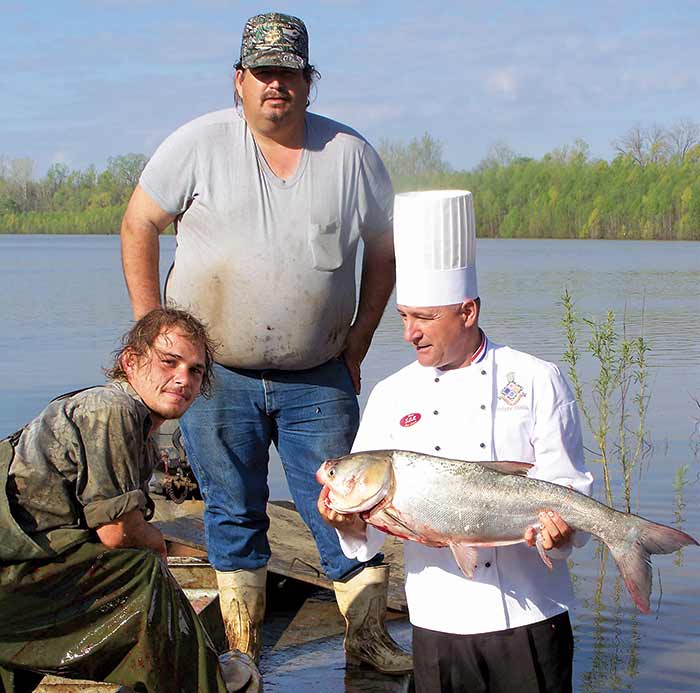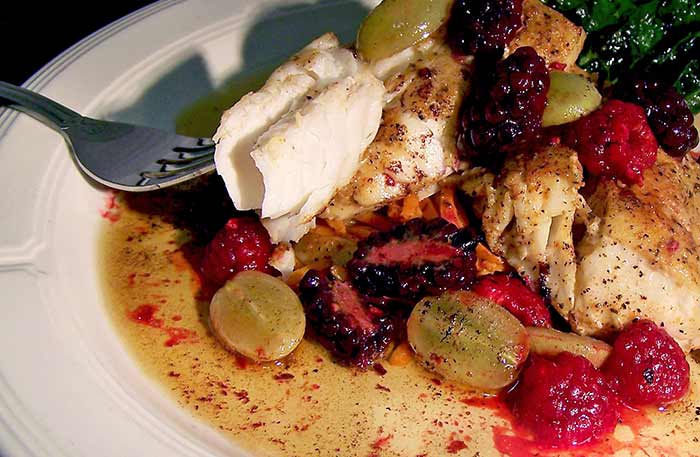Advertisement
In the face of an invasion, sometimes you have to dig in.

Chef Philippe Parola offers a large Asian Carp to two fishermen. The success of the chef's larger plan hinges on fishermen and customers making a success of commercial carp fishing. (Photo: Chef Philippe Parola)
The only mystery about the carp in the pond near Jackson Landers's parents' house in Free Union, Virginia, is how best to catch them. These carp had arrived without fanfare, Landers explains. Pointing at the neighbor's place, overlooking the pond, he says the folks next door just wanted the water cleared up, so they brought in the fish. This is a mini-version of the original tale of the Asian carp that have infested America's waterways, and threaten the Great Lakes — a catfish farmer (locations and times vary with the telling) imported the carp to clean his catfish ponds, they escaped, and have been taking over feeding grounds ever since.
Here at the pond, there's no way out, so the carp provide a captive test group for Landers and his experiments. Today, he's fishing without success. The next step will involve a bow and arrow, and if that fails, a shotgun. If he has his way, then the carp will be caught and the carp will be prepared and the carp will be eaten. Not just the carp in this small pond, but all of them.
Landers (no relation to this writer), who writes a blog called Locavore Hunter, is a former vegetarian who teaches hunting classes, and his book, The Beginner's Guide to Deer Hunting for Food, is due out in September. Now, he's writing a new book entitled Eating Aliens, pitching a related TV show, and he hasn't yet met a species he cannot stomach, given enough garlic and butter.

Jackson Landers is on a quest to clean up invasive species one
forkful at a time.
Anyone who's ever typed the words "Asian carp" into a YouTube search (go ahead, we'll wait) knows how to catch them. Drive a motorboat down the areas of the Mississippi where they threaten to destroy local ecosystems, and the fish will jump by the hundreds — over, around, and into the boat and whoever happens to be standing in their flight path.
Through ballast water or careless aquaculture, invasive species of various stripes threaten local species from Maine to California. Landers believes that's a problem we can eat our way out of. After all, look what we did to cod. By catching, cooking, and eating the right species, we can strike a blow for the environment from the safety of a dinner plate. He's not alone in this belief.
The Silverfin Gambit
Philippe Parola is a Baton Rouge-based chef and food consultant. In 2009, he and the Louisiana Department of Wildlife kicked off a campaign to rebrand Asian carp and market them as desirable seafood. This is not Parola's first attempt at culinary genocide. In the 1980s, at the request of a local trapper who was unable to find a market for alligator skins in the clothing markets of Europe, he was at the forefront of attempts to popularize alligator meat, which met with some success. His campaign against the nutria, a large rodent released in Louisiana after a hurricane knocked down the fence that contained them, was less successful. These days, Chef Philippe has ambitious plans for the fish he'd prefer you call "silverfin."
The first meeting between chef and carp came unexpectedly. "For 25 years," says the avid boater, "I took off from the restaurant to go fishing religiously, maybe two or three days a week. It's a big thing for me." A few years ago, he was called in as a consultant for a television show, to catch and cook alligator gar, a prehistoric throwback fish native to Louisiana's Atchafalaya River. While he was out on the river with a professional guide he'd hired to ensure success, a pair of carp landed at Parola's feet. It was a big fish he'd never seen locally, so the chef had a few questions. Actually, just one question.
"Why doesn't anybody want to eat this fish?" he says. "I went home and found the problem. There are too many bones in that fish." On this point, everyone but the carp agrees. The carp's Y-shaped floating bones, which make it a powerful swimmer capable of leaping into the air, also make it more challenging to clean. Duane Chapman, a fisherman and U.S. Geological Survey wildlife biologist, in a video on the subject, says it takes a novice about 20 minutes to clean a carp. The result, according to those who've eaten the fish, and those in other nations for whom it's a common meal — carp have been cultivated for food in China for thousands of years — is well worth it. Parola compares the sweet taste to a cross between scallops and crabmeat.

Photo: Chef Philippe Parola
The size of the fish, coupled with the ease of the catch, could entice hungry fishermen to take the time to clean them, but Parola doesn't believe that's the answer. The key to getting rid of the Asian carp is to eat them out of existence, and we've done it before; Parola points to his friend Paul Prudhomme's recipe for redfish, which contributed to thinning the population of that fish. But the carp problem requires more than a bunch of adventurous eaters. It takes a commercial fishery.
Parola's "Silverfin Craze" line of microwavable carp meals will be coming to a grocer's freezer near you, as soon as the chef can raise money to outfit a plant for his proprietary carp-deboning process; he envisions a market large enough to take a bite out of Asian carp. "The scientist, the politician, the biologist — these are not the guys who will make a difference," he says. "The guy who will make a difference is the consumer."
The Redneck Campaign
Betty DeFord, the otherwise upbeat bar manager at the Boat Tavern in Bath, Illinois, worries that there's no solution to the carp problem. From the converted barge, on a branch of the Illinois River called the Bath Chute, she's seen the carp problem multiply over the last decade. The first carp she saw jumped into her boat while she and her husband were out on the water together. The second came in the door of the bar, carried by a patron who wanted to show off his strange catch. As she chats on the phone, she watches them jumping in the Chute, and says carp have substantially altered life in Bath.
"This is a small community," she says. "Boating and fishing are the big things, because there isn't that much to do for kids around here. This really has taken that away from the kids. I'm a parent and a grandparent, and I'm not going to put one of our kids out there endangering their lives. If we can reclaim our waters, we can take our kids out, and people can take their grandkids out and enjoy the watersports we once did." DeFord won't let her grandchildren come out on the boat since she took a blow to the shoulder from a jumping carp that left her black and blue. She recounts a trip in her 16-foot johnboat with her daughter and a friend who'd never seen the carp. "We got into a school of these fish not too far away from the Boat Tavern," she says. "They were shooting up out of the water like torpedoes. There were so many fish jumping, we were hitting them out of the boat with brooms. We were using boat oars, anything we could think of to protect ourselves. We were all just a bloody, slimy mess when this was over. We ended up with 32 of them in the boat, not counting the ones we batted out. Right then and there we decided this was scary business. We had to do something to deal it."
Advertisement
Back at the Boat Tavern, DeFord and friends thought up a scheme to, if not get rid of the carp, at least get some publicity for what had happened to their waterways. The Redneck Fishing Tournament has succeeded beyond anything DeFord had hoped. Every year (this year is the tournament's seventh), Bath plays host to 10 times its population of 350 people, and they come with boats, bats, and nets to try their hand at landing one of the world's easiest-to-catch fish: the silver carp.
At last year's tournament, fishermen took about 3,000 pounds of carp out of the river, in four two-hour heats over the course of a weekend. In years past, DeFord has given the fish to a pair of physicians from Ames, Iowa, with a plan to grind them into fishmeal and omega-3 oil. Another operation, in Pike County, Illinois, fishes carp commercially and exports them to China. DeFord says she watched them take around 5,000 pounds a day from the water by the Boat Tavern just after last Christmas, stopping only when the Chute iced over.
Did it have an effect? "I don't notice a difference," she says. "There's so many of them, even though they're harvesting them, I don't think we'll ever get rid of them." She signs off, with a warning from the Boat Tavern in Bath, Illinois: "Do not let these fish get in your waters. If they do, it's too late."
In the future, there will probably be entire film festivals devoted to short movies of boaters dodging flying silver carp. For now, this video from Outdoor Adventure TV is a fine example of the genre.
The South Atlantic Front
The carp isn't the only invader on the menu. Since the first recorded Atlantic sighting in 1985, lionfish, a species native to the Indo-Pacific region, have established themselves from North Carolina to the Gulf of Mexico.
Let's take care of the good news first. "Luckily, lionfish don't jump out of the water," Lad Akins says. "Thirteen spines flying at you? That would not be a good thing." Akins is the director of special projects for Reef, an environmental organization of recreational divers that has been dealing with the lionfish since 2006. Further, he says, lionfish are a delicacy, and fairly easy to prepare. He likes a lionfish ceviche, but says that any of the 45 recipes in Reef's The Lionfish Cookbook are pretty darn good, and he's done a fair bit of taste testing. Lionfish can be cleaned like any other fish; Akins says the process is similar to mahi, with one extra step. You need to remove the venomous spines.
"There've been no known deaths from lionfish stings, but the stings can be very painful, and there can be complications," Akins says. "So just cut the spines off with a pair of scissors. Then it's just like any other fish."
Outside of aquariums, lionfish live primarily on and near coral reefs. It's believed by the National Oceanic and Atmospheric Association (NOAA), who have their own "Eat Lionfish" information campaign, that their arrival in the Atlantic came by way of aquariums, either broken in hurricanes, or dumped intentionally into the sea. The fish are slow moving, feed mostly at night, and live at depths of 85 to 260 feet. The spines, which, along with the distinctive stripes, are their most striking feature, aren't used for hunting, but for defense. The biggest danger from lionfish is not to humans, but to other species. Lionfish are an effective predator, and will eat just about anything they can fit in their mouths. Akins says Reef researchers have found 60 different species of fish in the stomachs of captured lionfish, along with shrimp, crab, and octopus.
"Our main concern isn't that we're seeing a lot of lionfish, but that lionfish are consuming our native species," he says. "In some areas where lionfish have become well-established, they far exceed any native species of fish. It appears there aren't any natural controlling predators, so it's really up to us."
In 2009, Reef held its first Lionfish Derby in the Bahamas. The one-day tournament netted 1,408 fish. Since then, three derbies have been established in the Florida Keys, and Reef is working on one in Palm Beach. There's a high demand for the fish — they grace the tables of restaurants in the Bahamas, Florida, and elsewhere. Most of the fish are caught with spear and net, one at a time, but Akins says commercial catches should increase as better techniques evolve: "The big issue is developing incentives for people to remove these fish. The derbies were one way; consumption is another. From the market standpoint of fishermen being able to sell their catch, but also from the local-consumption standpoint of people going out, and instead of shooting a grouper, they shoot a lionfish, and bring that home to eat."
Duane Chapman, carp expert and biologist for the U.S. Geological Survey, has put together a series of videos on cleaning Asian Carp, courtesy of Louisiana State University.
This is just part 1. Watch Part 2 and Part 3.
Akins doesn't think his efforts will result in the disappearance of lionfish in the Atlantic — they're too well established for that — but the campaign against the lionfish isn't hopeless. "We're talking about lionfish from North Carolina into South America, so eradicating these fish is probably not going to happen. But when we talk about certain areas — like marine-protected areas; key ecological areas; nursery areas for other fish; areas where lionfish could come into contact with humans, such as beach or swimming areas — control in those areas can be very effective to keep numbers down and minimize impact."
That may be all the gastronomic crusaders can hope for — fighting the invasive species to the draw — but there is no shortage of ingredients for the adventurous diner. Rapa Whelk fritters have been sighted on dinner tables in Virginia; a cookbook released in 2007 (The Invasive Species Cookbook by J.M. Franke) trumpets the joy of eating, among others, European green crab and New Zealand mud snails, both considered invasive in Oregon; and Minnesotans have brought the Louisiana-style crawfish boil to bear as a weapon against the rusty crayfish trying to move into the upper Midwest.
In some ways, the problems of invasive species are as old as man's desire to colonize, and a simple change of location can turn a harmless beast into a threatening invader. The rabbit has terrorized Australia since its introduction in 1859, and the starling, which destroys crops across the United States, was introduced in Central Park more than a century ago by a man who wanted to populate the country with every bird mentioned in the plays of Shakespeare. Even the culinary solution has been attempted before. In 1931, the U.S. Department of Agriculture published a recipe for starling pie. Today, the European starling is one of the most abundant bird species in North America — the pie remains a rarity.
Jackson Landers, who hopes more diners will choose to eat for the environment, sees a convergence of local food, semi-subsistence hunting, and promotion of native species on the horizon. A few days after his attempt on the carp in the pond near his parents' house, he caught a plane to the Bahamas, where he had a line on some lionfish.
Wine (And Wise) Up On Sustainable Seafood
If invasive species aren't yet on your menu, you can still eat responsibly thanks to the Blue Ocean Institute's FishPhone app for iPhones. This app lets you know if the fish you're considering is a threatened species the next time you go to a restaurant, and if it is, offers sustainable choices instead. You can see Blue Ocean's list of species at www.blueocean.org, or download and print a wallet-sized card to let you know whether you're doing the right thing by devouring that Orange Roughy or Chilean Sea Bass (you aren't). Maybe order the mahi-mahi or albacore instead?
This app also offers suggestions for wine pairings courtesy of Brancott wineries, a founding member of Sustainable Winegrowing New Zealand, and recipes to help your ocean-friendly choices.
No iPhone? No problem. Just text the word BLUE to 30644 with the message FISH and the name of the fish you're considering, and get the Institute's assessment and better alternatives. You can also text the word BLUE to 30644 to opt-in to receive ocean-alerts, info on new seafood rankings, and cooking tips on "good" fish to eat.
